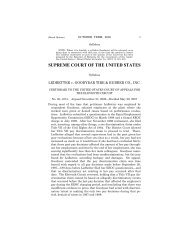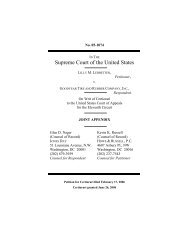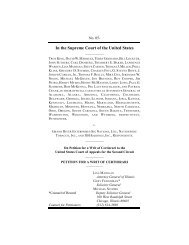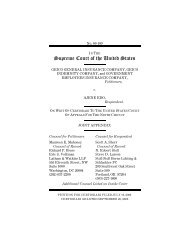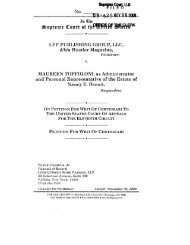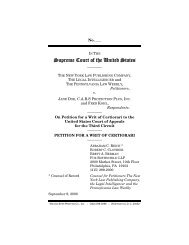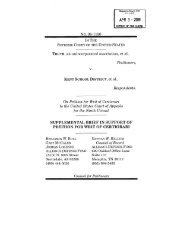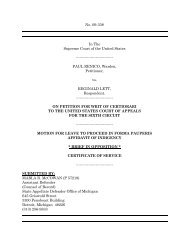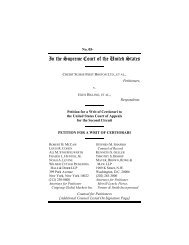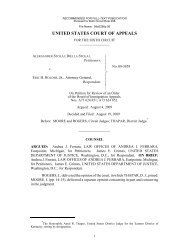Petition for certiorari - SCOTUSblog
Petition for certiorari - SCOTUSblog
Petition for certiorari - SCOTUSblog
You also want an ePaper? Increase the reach of your titles
YUMPU automatically turns print PDFs into web optimized ePapers that Google loves.
Supreme Cou~ U.S.<br />
FILED<br />
0 7- 2 1 1 AUG 1 5 2007<br />
No. 0%<br />
OFFICE OF THE CLERK<br />
IN THE<br />
~upreme {£ourt of t~e ~niteb ~tate~<br />
ROCIO SANCHEZ, OLGA CASTRO, MYRNA MARTINEZ, KAREN<br />
BJORLAND, CHERYL MACLYMAN, AND RHONDA KERN,<br />
<strong>Petition</strong>ers,<br />
v.<br />
COUNTY OF SAN DIEGO~ ET AL.,<br />
Respondenls.<br />
On <strong>Petition</strong> <strong>for</strong> a Writ of Certiorari to the<br />
United States Court of Appeals <strong>for</strong> the Ninth Circuit<br />
PETITION FOR A WRIT OF CERTIORARI<br />
ERIC ALAN ISAACSON<br />
BONNY E. SWEENEY<br />
AMBER L. ECK<br />
LERACH COUGHLIN STOIA GELLER<br />
RUDMAN & ROBBINS LLP<br />
655 West Broadway, Suite 1900<br />
San Diego, Cali<strong>for</strong>nia 92101<br />
(619) 231-1058<br />
DAVID BLAIR-LOY<br />
ACLU FOUNDATION OF SAN<br />
DIEGO & IMPERIAl. COUNTIES<br />
450 B Street, Suite 1420<br />
San Diego, Cali<strong>for</strong>nia 92101<br />
(619) 232-2121<br />
A llornejs Jor <strong>Petition</strong>ers<br />
WALTER DELLINGER<br />
(Counsel of Record)<br />
PAMEt.A HARRIS<br />
PAMMELA QUINN<br />
O’MELVENY & MYERS LLP<br />
1625 Eye Street, N.W.<br />
Washington, D.C. 20006<br />
(202) 383-5300<br />
STEVEN R. SHAPIRO<br />
AMERICAN CIVIL LIBERTIES<br />
UNION FOUNDATION<br />
125 Broad Street<br />
New York. New York 10004<br />
(212) 549-2500<br />
WILSON-EPES PRINTING Co., INC. -- (202) 789-0096 - WASHINGTON, D. C. 20002<br />
®,~ ~o
QUESTION PRESENTED<br />
In 1971, this Court held in Wyman v. James, 400 U.S.<br />
309, 317, that a state official’s entry into a welfare<br />
recipient’s home does not constitute a "search" subject to<br />
Fourth Amendment standards because it occurs outside the<br />
"traditional criminal law context." Subsequent decisions of<br />
the Court have called that holding into very serious question,<br />
but have not overruled it outright. The result is a recognized<br />
circuit conflict over whether home entries in the socialservices<br />
context are "searches" <strong>for</strong> Fourth Amendment<br />
purposes and, if so, what Fourth Amendment standard<br />
applies. The circuits also are divided on the more specific<br />
question of whether the Fourth Amendment permits the<br />
government to require that all welfare applicants submit to<br />
suspicionless home entries as a condition of eligibility.<br />
In order to resolve these conflicts, petitioners ask this<br />
Court to answer the following question presented:<br />
Are suspicionless searches like those required by San<br />
Diego County as a condition of welfare eligibility, in which<br />
pursuant to a program developed by the district attorney’s<br />
office, county fraud investigators from the district attorney’s<br />
office enter all applicants’ homes and look through their<br />
most intimate areas, a violation of the applicants’ Fourth<br />
Amendment rights?
ii<br />
PARTIES TO THE PROCEEDING<br />
<strong>Petition</strong>ers are Rocio Sanchez, Olga Castro, Myrna<br />
Martinez, Karen Bjorland, Cheryl Maclyman, and Rhonda<br />
Kern, applicants <strong>for</strong> public assistance subject to San Diego<br />
County’s "Project 100%" program requiring home entries by<br />
agents of the County District Attorney’s office as a condition<br />
of welfare eligibility, plaintiffs-appellants below.*<br />
Respondents are the County of San Diego; San Diego<br />
County Board of Supervisors; San Diego County Department<br />
of Health and Human Services; Jean Shepard, Director of the<br />
San Diego County Health and Human Services Agency, in<br />
her official capacity; San Diego Office of District Attorney;<br />
and Bonnie Dumanis, District Attorney of the County of San<br />
Diego, in her official capacity, defendants-appellees below.**<br />
A further plaintiff, "Aurora," whose name appears in the Ninth<br />
Circuit caption did not participate in the litigation be<strong>for</strong>e the Ninth<br />
Circuit, and is not included among the petitioners to this Court.<br />
Both Bonnie Dumanis and Jean Shepard are substituted in place<br />
of the prior officeholders who were sued in their official capacities. See<br />
Fed. R. App. P. 43(c)(2).
iii<br />
TABLE OF CONTENTS<br />
Page(s)<br />
QUESTION PRESENTED ....................................................i<br />
PARTIES TO THE PROCEEDING ................................~ .....ii<br />
TABLE OF AUTHORITIES ................................................v<br />
PETITION FOR A WRIT OF CERTIORARI ......................1<br />
OPINIONS BELOW ............................................................. 1<br />
JURISDICTION .................................................................... 1<br />
CONSTITUTIONAL PROVISION INVOLVED ................2<br />
STATEMENT OF THE CASE .............................................2<br />
A. Factual Background ......................................3<br />
B. Proceedings Below ........................................6<br />
REASONS FOR GRANTING THE PETITION ..................9<br />
I. RECOGNIZED TENSION IN THIS<br />
COURT’S JURISPRUDENCE HAS<br />
PRODUCED A CIRCUIT CONFLICT<br />
OVER THE FOURTH AMENDMENT<br />
STATUS OF HOME ENTRIES RELATED<br />
TO SOCIAL-SERVICES PROGRAMS .................10<br />
A. It Is Not Clear From This Court’s Decisions<br />
Whether Wyman Is Still Good Law ............ l0<br />
B. Confusion Over The Status Of Wyman Has<br />
Produced A Conflict In The Courts Of<br />
Appeals ........................................................14<br />
C. This Court Should Clarify That Wyman Does<br />
Not Permit The Kind Of Search Conducted<br />
Here .............................................................18
iv<br />
TABLE OF CONTENTS<br />
(continued)<br />
Page(s)<br />
II.<br />
THIS CASE PRESENTS AN IDEAL<br />
VEHICLE FOR ADDRESSING THE<br />
IMPORTANT CONSTITUTIONAL<br />
QUESTION AT STAKE ........................................21<br />
CONCLUSION ...................................................................22<br />
APPENDIX .........................................................................1 a<br />
Appendix A: Ninth Circuit Court of Appeals<br />
Opinion, filed Sept. 19, 2006 ........................................1 a<br />
Appendix B: District Court Order Granting<br />
Summary Judgment, Mar. 7, 2003 .............................. 52a<br />
Appendix C: District Court Order re Final<br />
Approval of Class Settlement, entered Dec. 16,<br />
2003 ............................................................................. 91 a<br />
Appendix D: Opinion of District Court, May 12,<br />
2003 ............................................................................. 97a<br />
Appendix E: Court of Appeals Order Denying<br />
<strong>Petition</strong> <strong>for</strong> Rehearing En Banc, April 16, 2007 ....... 11 la<br />
Appendix F: District Court Final Judgment dated<br />
Dec. 31, 2003, entered Jan. 5, 2004 ..........................120a
V<br />
TABLE OF AUTHORITIES<br />
CASES<br />
Page(s)<br />
Calabretta v. Floyd,<br />
189 F.3d 808 (gth Cir. 1999) ............................. 15, 16, 19<br />
Chandler v. Miller,<br />
520 U.S. 305 (1997) ...................................................... 14<br />
City of Indianapolis v. Edmond,<br />
531 U.S. 32 (2000) ........................................................ 16<br />
Ferguson v. City of Charleston,<br />
532 U.S. 67 (2001) ........................................................ 16<br />
Good v. Dauphin County Soc. Servs. <strong>for</strong><br />
Children & Youth,<br />
891 F.2d 1087 (3d Cir. 1989) .................................. 15, 16<br />
Griffin v. Wisconsin,<br />
483 U.S. 868 (1987) ...................................................... 14<br />
Illinois v. Lidster,<br />
540 U.S. 419 (2004) ...................................................... 12<br />
Illinois v. Rodriguez,<br />
497 U.S. 177 (1990) ...................................................... 17<br />
Kyllo v. United States,<br />
533 U.S. 27 (2001) ........................................................ 13<br />
Lenz v. Winburn,<br />
51 F.3d 1540 (llth Cir. 1995) ....................................... 15<br />
Mich. Dep ’t of State Police v. Sitz,<br />
496 U.S. 444 (1990) ...................................................... 14<br />
New Jersey v. T.L.O.,<br />
469 U.S. 325 (1985) ................................................ 11, 12<br />
Payton v. New York,<br />
445 U.S. 573 (1980) ................................................ 12, 13<br />
Reyes v. Edmunds,<br />
472 F. Supp. 1218 (D. Minn. 1979) .............................. 18
vi<br />
TABLE OF AUTHORITIES<br />
(continued)<br />
Page(s)<br />
Roe v. Tex. Dep ’t of Protective & Regulatory<br />
SeFvs. ,<br />
299 F.3d 395 (5th Cir. 2002) ................................... 14, 21<br />
Roska v. Peterson,<br />
328 F.3d 1230 (10th Cir. 2003) ......................... 15, 16, 21<br />
S.L. v. Whitburn,<br />
67 F.3d 1299 (7th Cir. 1995) ............................. 15, 17, 19<br />
Vernonia Sch. Dist. 47J v. Acton,<br />
515 U.S. 646 (1995) ...................................................... 12<br />
Wildauer v. Frederick County,<br />
993 F.2d 369 (4th Cir. 1993) ............................. 15, 16, 21<br />
Wilson v. Arkansas,<br />
514 U.S. 927 (1995) ...................................................... 12<br />
Wyman v. James,<br />
400 U.S. 309 (1971) .............................................. .passim<br />
CONSTITUTIONAL PROVISION<br />
U.S. Const. amend. IV .......................................................... 2<br />
STATUTES<br />
28 U.S.C. § 1254 ................................................................... 1<br />
28 U.S.C. § 1331 ................................................................... 6<br />
OTHER AUTHORITY<br />
Amy Mulzer, Note, The Doorkeeper and the<br />
Grand Inquisitor: The Central Role of<br />
Verification Procedures in Means-Tested<br />
Welfare Programs, 36 Colum. Hum. Rts.<br />
L. Rev. 663 (2005) .................................................. 19, 20
PETITION FOR A WRIT OF CERTIORARI<br />
<strong>Petition</strong>ers Rocio Sanchez, Olga Castro, Myrna Martinez,<br />
Karen Bjorland, Cheryl Maclyman, and Rhonda Kern<br />
respectfully petition <strong>for</strong> a writ of <strong>certiorari</strong> to review the<br />
judgment of the United States Court of Appeals <strong>for</strong> the Ninth<br />
Circuit.<br />
OPINIONS BELOW<br />
The court of appeals’ decision is reported at 464 F.3d<br />
916 and is reprinted in the Appendix to the <strong>Petition</strong> ("App.")<br />
at l a-51a. The court of appeals’ order denying en banc<br />
rehearing is reported at 483 F.3d 965 and is reprinted at App.<br />
llla-ll9a. The district court’s March 7, 2003, order<br />
granting summary judgment, which the Ninth Circuit<br />
reviewed and affirmed, appears in the appendix hereto at<br />
App. 52a-90a. ~<br />
JURISDICTION<br />
The court of appeals issued its decision on September 19,<br />
2006. App. la. A timely petition <strong>for</strong> rehearing en banc was<br />
denied on April 16, 2007. App. llla. This Court granted<br />
petitioners’ request <strong>for</strong> an extension of time to petition <strong>for</strong><br />
<strong>certiorari</strong> to and including August 15, 2007. This Court has<br />
jurisdiction pursuant to 28 U.S.C. § 1254(1).<br />
~ A subsequent opinion that resolved certain matters not at issue here<br />
was entered on May 12, 2003, and is available electronically at 2003 U.S.<br />
Dist. LEXIS 27351 (S.D. Cal. May 12, 2003). It appears in the appendix<br />
hereto at App. 97a-110a. A settlement of all remaining issues was<br />
approved on December 12, 2003, by an order entered on December 16,<br />
2003, App. 91a-96a, clearing the way <strong>for</strong> an appealable final judgment<br />
dated December 31, 2003, and entered January 5, 2004, App. 120a-125a.
CONSTITUTIONAL PROVISION INVOLVED<br />
The Fourth Amendment of the United States Constitution<br />
provides:<br />
The right of the people to be secure in their<br />
persons, houses, papers, and effects, against<br />
unreasonable searches and seizures, shall not<br />
be violated, and no warrants shall issue, but<br />
upon probable cause, supported by oath and<br />
affirmation, and particularly describing the<br />
place to be searched, and the persons or things<br />
to be seized.<br />
STATEMENT OF THE CASE<br />
San Diego County’s "Project 100%" requires every<br />
welfare applicant, including those <strong>for</strong> whom there is no basis<br />
<strong>for</strong> suspecting ineligibility or fraud--and even those able to<br />
prove eligibility through other, less intrusive means--to<br />
submit to a "home visit" from the County District Attorney’s<br />
Public Assistance Fraud Division. This visit entails a<br />
required home entry and can involve detailed inspection of<br />
personal areas of the home, including bedrooms and<br />
bathrooms.<br />
The express purpose of the program is to uncover<br />
evidence of ineligibility or fraud. The County also<br />
anticipates that the program may uncover evidence that will<br />
lead to criminal prosecution of applicants <strong>for</strong> past welfare<br />
fraud or <strong>for</strong> crimes other than welfare fraud. Failure to<br />
comply with the required "home visit" necessarily results in<br />
denial of welfare benefits.<br />
The Ninth Circuit invoked this Court’s decision in<br />
Wyman v. dames, 400 U.S. 309 (1971), to uphold the<br />
program. It did so despite recognizing explicitly that<br />
intervening decisions by this Court call into question the<br />
continuing validity of Wyman’s broad holding that the<br />
Fourth Amendment does not apply at all under these
circumstances. It also did so over the "trenchant" dissenting<br />
opinion of a member of the panel, see App. 119a (Kozinski,<br />
J., dissenting from denial of rehearing en banc) (describing<br />
Judge Fisher’s panel dissent). The divisive nature of the<br />
issue prompted further dissent from eight of the active judges<br />
on the court of appeals below on the question whether<br />
rehearing en bane was warranted. App. 112a-118a.<br />
The decision below deepens a long-standing conflict<br />
among the courts of appeals on the status of Wyman and the<br />
Fourth Amendment standard applicable to home entries in<br />
the social-services context. It also puts the Ninth Circuit in<br />
direct conflict with the Seventh on the constitutionality of<br />
programs like the one at issue here. Review by this Court is<br />
warranted to resolve the uncertainty relating to these<br />
important constitutional questions.<br />
A. Factual Background<br />
San Diego’s Project 100% was conceived in 1997 by the<br />
County District Attorney’s Office, with the stated aim of<br />
"redoubling" its ef<strong>for</strong>ts to combat welfare fraud and assure<br />
"program integrity. ’’2 In fact, the program was launched at a<br />
time when the number of welfare agency referrals to the<br />
District Attorney’s office requesting <strong>for</strong>-cause<br />
investigations--/, e., in cases where there was some reason to<br />
suspect ineligibility--was sharply declining. 3 As the<br />
County’s welfare case load more than halved from 1994 to<br />
1999, <strong>for</strong>cing a 37% reduction in County welfare staff, and<br />
2 Se.e, e.g., Excerpts of the Record ("ER") 86 Ex. 48, at 14 (Answer<br />
64); ER 85 Ex. 1, at 36, 115 (Apr. 22, 2002 Dep. Test. of L. Aragon,<br />
Deputy Dist. Attorney, Pub. Assistance Fraud Division Chief ("Aragon<br />
Dep.")); ER 85 Ex. 18, at 60 (Apr. 18, 2002 Dep. Test. of J. Zinser,<br />
Deputy Dir. <strong>for</strong> Strategy & Planning Div., Health & Human Servs.<br />
Agency).<br />
3 ER 86 Ex. 38 (Mar. 5, 1997 Mem. from L. Aragon to G.<br />
Thompson, Asst. Dist. Attorney).
4<br />
as "<strong>for</strong>-cause" referrals to the District Attorney’s office <strong>for</strong><br />
investigations of suspected fraud dropped, the District<br />
Attorney avoided staffing cuts by assigning its Fraud<br />
Investigators the new task of investigating every welfare<br />
applicant by looking through their homes on Project 100%<br />
home visit "walk-throughs. ’’4<br />
Pursuant to the Project 100% program, every welfare<br />
applicant is in<strong>for</strong>med that a mandatory "home visit" must be<br />
completed be<strong>for</strong>e he or she will be approved <strong>for</strong> aid. App.<br />
3a-4a. The applicant is not told when this "home visit" will<br />
occur, although generally it takes place during regular<br />
business hours within 10 days of the application. Id. at 3a.<br />
The home visits are conducted not by social workers, but by<br />
"investigators from the Public Assistance Fraud Division of<br />
the D.A.’s office, who are sworn peace officers with badges<br />
and photo identification." Id.<br />
Once they arrive at the applicant’s home, the District<br />
Attorney’s agents interview the applicant and then conduct a<br />
"walk-through" of the home. App. 4a. During this walkthrough,<br />
"[t]he investigator will also ask the applicant to<br />
view the interior of closets and cabinets." Id. 5 Failure to<br />
4 See ER 85 Ex. 16, at 16-17 (Jan. 30, 2002 Dep. Test. of J.<br />
Vukotich, Asst. Deputy Dir., Health & Human Seres. Agency); ER 85<br />
Ex. 21, at 3226 (Mar. 14, 2000 Health & Human Servs. Agency Mem.<br />
noting decline in County welfare staff as caseloads dropped, but that<br />
"[i]n contrast, the District Attorney’s investigation staff has not changed<br />
during this time period").<br />
5 The investigators look through bedroom closets and dresser<br />
drawers. See, e.g., ER 85 Ex. 7, at 53-54 (Apr. 29, 2002 Dep. Test. of J.<br />
Duvall, Public Assistance Fraud Investigator, Office of Dist. Attorney<br />
("Duvall Dep.")); ER 85 Ex. 9, at 55-56 (Dec. 12, 2001 Dep. Test. of J.<br />
Hale, Supervisor of Dep’t of Soc. Servs. Fraud Bureau); ER 85 Ex. 2, at<br />
69-71 (Feb. 14, 2002 Dep. Test. of E. Bogard, Public Assistance Fraud<br />
Investigator, Office of Dist. Attorney ("Bogard Dep.")); ER 85 Ex. 7, at<br />
52-53 (Duvall Dep.). They inspect bathrooms and medicine cabinets,<br />
count toothbrushes, and look <strong>for</strong> men’s bath products. ER 85 Ex. 8, at<br />
82-83 (Apr. 3, 2002 Dep. Test. of E. Gonzalez, Fmr. Fraud Prevention
submit to the "home visit" (including the "walk-through")<br />
automatically results in denial of the application <strong>for</strong> public<br />
assistance. Id. at 3a-4a.<br />
The express purpose of these investigations is to uncover<br />
evidence of fraud in connection with the welfare application.<br />
Id. In addition, should they find it, "the investigators are<br />
required to report evidence of potential criminal wrongdoing<br />
<strong>for</strong> further investigation and prosecution." Id. at 4a. This<br />
extends beyond the application that is the subject of the<br />
home entry: investigators will refer <strong>for</strong> prosecution evidence<br />
of other criminal behavior. App. 4a n.3. The D.A.’s Public<br />
Assistance Fraud Division chief testified that his<br />
investigators are trained not to give rehabilitative counseling<br />
or advice to applicants, and that their "focus is highly<br />
limited" to legal compliance:<br />
[I]t is not our expectation that they are going<br />
to go outside of that. And I’m trying to<br />
envision what a rehabilitation would be under<br />
those circumstances. Get off the couch. Get<br />
a job. I don’t know. So, no... --so I--no. I<br />
don’t envision rehabilitation as a part of that.<br />
I can’t even imagine what that would look<br />
like.<br />
ER 85 Ex. l, at 170-71 (Aragon Dep.).<br />
Supervisor ("Gonzalez Dep.")); ER 85 Ex. 12, at 46 (Aug. 21, 2001 Dep.<br />
Test. of Pet’r Myrna Martinez ("Martinez Dep.")). They look through<br />
children’s bedrooms and inspect the children’s belongings, including<br />
their clothing and even their dirty laundry. ER 85 Ex. 8, at 84 (Gonzalez<br />
Dep.); ER 85 Ex. 2, at 88-90 (Bogard Dep.); ER 85 Ex. 14, at 51 (Apr.<br />
25, 2002 Dep. Test. of F. Reid, Supervising Investigator, Office of Dist.<br />
Attorney ("Reid Dep.")). They also request closer inspection of potential<br />
evidence, such as bank statements or other personal papers they might<br />
spot on a desk. ER 85 Ex. 5, at 77 (May 2, 2002 Dep. Test. ofL. Crosby,<br />
Training Supervisor, Pub. Assistance Fraud Investigation); ER 85 Ex. 7,<br />
at 21 (Duvall Dep.).
6<br />
When the investigator conducts the home inspection, no<br />
part of the home is off-limits, and no official policy or<br />
protocol limits or guides the discretion of investigators in<br />
deciding where to search inside the home or what items to<br />
inspect. 6 Not surprisingly, subjects of these home<br />
investigations testified that they were "frightened," "upset<br />
and degraded," and even reduced to tears by the District<br />
Attorney’s "humiliating and embarrassing" intrusions into<br />
their homes. 7<br />
B. Proceedings Below<br />
1. <strong>Petition</strong>ers, applicants <strong>for</strong> public assistance in San<br />
Diego County, brought the instant case, a facial challenge to<br />
Project 100% as a violation of the Fourth Amendment’s<br />
guarantee against unreasonable searches. 8 The district<br />
court’s jurisdiction was invoked under 28 U.S.C. § 1331.<br />
After certifying a class, the district court granted the<br />
defendants’ motion <strong>for</strong> summary judgment. App. 52a-90a.<br />
2. a. A divided panel of the Ninth Circuit affirmed, App.<br />
la-51a, relying almost exclusively on Wyman v. James, 400<br />
U.S. 309, a 1971 decision of this Courtl In Wyman, the<br />
Court held that a home visit by a government social worker<br />
to the home of a government aid recipient did not constitute<br />
a "search" <strong>for</strong> Fourth Amendment purposes. Because the<br />
home visit did not arise "in the traditional criminal law<br />
context," the Court reasoned, it could not "be equated with a<br />
search" implicating the Fourth Amendment. [d. at 317. And<br />
even assuming the home visit could be treated as a search,<br />
6 ER 85 Ex. 14, at 65 (Reid Dep.); ER 85 Ex. 7, at 19 (Duvall Dep.).<br />
7 ER 85 Ex. 3, at 43-44 (Aug. 21, 2001 Dep. Test. of Pet’r Karen<br />
Bjorland); ER 85 Ex. 12, at 40, 43-46 (Martinez Dep.).<br />
8 Although petitioners sought relief under a variety of additional<br />
state and federal theories, this Court’s review is sought only with respect<br />
to the controlling federal constitutional law issues.
the Court continued, it was valid under the Fourth<br />
Amendment because it was not unreasonable, ld.<br />
Applying Wyman, the panel majority held, first, that no<br />
Fourth Amendment "search" occurs when, as a condition of<br />
welfare eligibility, agents of the District Attorney enter and<br />
walk through ~a private home (including bedrooms and<br />
bathrooms), searching <strong>for</strong> evidence of welfare ineligibility or<br />
welfare fraud. As a result, the Fourth Amendment simply is<br />
not implicated by the Project 100% home entries and walkthroughs.<br />
App. 6a- 10a.<br />
In the alternative, the panel went on to hold--again<br />
relying on Wyman--that even if the home entries could be<br />
characterized as "searches," such searches would be<br />
"reasonable" as a matter of law under the Fourth<br />
Amendment. App. l la-21a. The majority explained:<br />
App 15a.<br />
[B]ecause the Project 100% visits serve an<br />
important governmental interest, are not<br />
criminal investigations, occur with advance<br />
notice and the applicant’s consent, and<br />
alleviate the serious administrative difficulties<br />
associated with welfare eligibility verification,<br />
we hold that the home visits are reasonable<br />
under the Supreme Court’s decision in<br />
Wyman.<br />
b. Judge Fisher dissented, unable to "agree with the<br />
majority’s conclusion" that Wyman "’directly controls’ our<br />
resolution of this case." App. 28a. Judge Fisher focused on<br />
significant distinctions between Project 100% and the home<br />
visits approved in Wyman:<br />
Wyman involved a primarily rehabilitative<br />
home visit by a social assistance<br />
caseworker .... That is a far cry from the<br />
program carried out by the County of San
8<br />
Diego, whose Project 100% home visits entail<br />
a law en<strong>for</strong>cement agent--trained not to give<br />
advice to welfare applicants--walking<br />
through the applicant’s home in search of<br />
physical evidence of ineligibility that could<br />
lead to criminal prosecution either <strong>for</strong> welfare<br />
fraud or other crimes unrelated to the welfare<br />
application.<br />
According to Judge Fisher, Wyman neither compelled<br />
nor warranted either of the majority’s holdings: that walkthroughs<br />
of homes by agents of the District Attorney are not<br />
Fourth Amendment "searches," or that even if they are,<br />
Project 100% would be "reasonable" under the Fourth<br />
Amendment. App. 28a-51 a.<br />
3. <strong>Petition</strong>ers filed a motion <strong>for</strong> rehearing en banc. App.<br />
11 la. The motion was denied, but only over public dissent<br />
by eight of the Ninth Circuit’s active judges. Judge Kozinski<br />
dissented "<strong>for</strong> the reasons expressed in Judge Fisher’s<br />
trenchant panel dissent." App. 119a. Judge Pregerson,<br />
writing <strong>for</strong> himself and six other judges, would have held<br />
that Wyman does not govern petitioners’ challenge to Project<br />
100%:<br />
The majority opinion clings to Wyman v.<br />
James, 400 U.S. 309 (1971), asserting that it<br />
directly controls this case. This is<br />
unsupportable <strong>for</strong> three reasons. First, as<br />
clearly outlined in Judge Fisher’s dissent, the<br />
program upheld in Wyman was significantly<br />
different in scope and goal from San Diego’s<br />
program. Second, allowing Wyman to<br />
constrict the bounds of our Fourth<br />
Amendment jurisprudence ignores over<br />
thirty-five years of intervening law. Third,<br />
allowing this opinion to stand is an assault on
9<br />
our country’s poor as we require them to give<br />
up their rights of privacy in exchange <strong>for</strong><br />
essential public assistance.<br />
App. 112a-113a.<br />
REASONS FOR GRANTING THE PETITION<br />
As recognized by both the panel majority and dissenting<br />
judges below, the holding of this Court’s 1971 decision in<br />
Wyman v. James has been called into serious question by<br />
subsequent decisions of the Court. As a result, the circuit<br />
courts are divided as to whether home entries in the socialservices<br />
context constitute "searches" subject to the Fourth<br />
Amendment and, if so, what Fourth Amendment standard<br />
governs their constitutionality. The lower courts also are in<br />
conflict on the narrower question presented here: whether<br />
programs like San Diego’s Project 100%, which condition<br />
welfare eligibility on submission to suspicionless home<br />
entries by fraud investigators, are permissible under the<br />
Fourth Amendment.<br />
Because the conflict in the lower courts is the product of<br />
the uncertain status of this Court’s own precedent, it is most<br />
unlikely to resolve itself without the Court’s intervention.<br />
This Court should grant <strong>certiorari</strong> to clarify the status of<br />
Wyman and, at a minimum, to confirm that Wyman’s<br />
analysis of rehabilitative home-visits by social workers has<br />
no application where, as here, agents of the District<br />
Attorney’s office with no rehabilitative agenda search the<br />
most intimate areas of a person’s home.
10<br />
I. RECOGNIZED TENSION IN THIS COURT’S<br />
JURISPRUDENCE HAS PRODUCED A CIRCUIT<br />
CONFLICT OVER THE FOURTH AMENDMENT<br />
STATUS OF HOME ENTRIES RELATED TO<br />
SOCIAL-SERVICES PROGRAMS.<br />
A. It Is Not Clear From This Court’s Decisions<br />
Whether Wyman Is Still Good Law.<br />
As even the panel majority below recognized, App. 1 la<br />
n.8, the continuing validity of Wyman v. James, 400 U.S. 309<br />
(1971), on which it rested its decision, has been called into<br />
serious question by subsequent decisions of the Court. That<br />
question, as well as the lower-court divisions it has produced,<br />
is likely to persist unless and until this Court directly<br />
addresses the status of Wyman.<br />
1. In 1971, this Court considered in Wyman whether the<br />
government could require that beneficiaries of the Aid to<br />
Families with Dependent Children ("AFDC") program<br />
submit to home visits by caseworkers or risk termination of<br />
benefits. 400 U.S. at 310. The Court concluded, first, .that<br />
the AFDC home visits did not constitute "searches" <strong>for</strong><br />
Fourth Amendment purposes. Because they did not arise "in<br />
the traditional criminal law context," the Court reasoned, the<br />
home visits could not "be equated with a search" implicating<br />
the Fourth Amendment. See id. at 317.<br />
The Court went on to say, in what amounted to dicta, that<br />
even if the AFDC home visits could be considered<br />
"searches," they would be permissible under the Fourth<br />
Amendment because they were not unreasonable. The Court<br />
relied <strong>for</strong> this conclusion on a close analysis of eleven factors<br />
implicated by the facts of the case be<strong>for</strong>e it. 9 It was careful<br />
9 The factors the Court considered relevant to the reasonableness of<br />
the AFDC home visits were: 1) the public interest in protecting the needs<br />
of the child who is the ultimate beneficiary of the welfare assistance; 2)<br />
the state interest in ensuring that assistance only reaches its intended
11<br />
not to suggest that "termination of benefits upon refusal of a<br />
home visit is to be upheld against constitutional challenge<br />
under all conceivable circumstances." ld. at 326.<br />
2. In the more than 35 years since Wyman was decided,<br />
this Court has decided a number of cases that are difficult, if<br />
not impossible, to square with Wyman’s holding that an<br />
AFDC home visit does not constitute a "search" under the<br />
Fourth Amendment. First, and most fundamentally, when<br />
Wyman was decided in 1971, it remained uncertain whether<br />
the Fourth Amendment "regulate[d] only searches and<br />
seizures carried out by law en<strong>for</strong>cement officers" engaged in<br />
criminal law-en<strong>for</strong>cement activities, or whether it extended as<br />
well to searches conducted by other state officials, as in the<br />
school and social-services contexts. New Jersey v. T.L.O.,<br />
469 U.S. 325,334-35 (1985) (search of students’ belongings<br />
by school officials). The Court answered that question in<br />
1985, in New Jersey v. T.L.O., holding---contrary to the first<br />
premise of Wyman--that government inspections that occur<br />
outside the traditional criminal context are indeed "searches"<br />
subject to Fourth Amendment constraints. Id.; cf Wyman,<br />
400 U.S. at 317 (concluding that the home visits in question<br />
beneficiaries; 3) the public’s interest and expectation in "know[ing] how<br />
[its] charitable funds are utilized and put to work"; 4) the interest in<br />
rehabilitation; 5) the fact that home visits are at "the heart of welfare<br />
administration"; 6) the relatively non-intrusive nature of the search at<br />
issue; 7) the fact that nothing in the record "supports an inference that the<br />
desired home visit [at issue] had as its purpose the obtaining of<br />
in<strong>for</strong>mation as to criminal activity"; 8) the inability of the state to verify<br />
all of the in<strong>for</strong>mation it sought solely through other, less-intrusive means;<br />
9) the visit is not one by police or uni<strong>for</strong>med authority but instead is<br />
conducted by a caseworker whose "primary objective is, or should be, the<br />
welfare, not the prosecution, of the aid recipient <strong>for</strong> whom the worker has<br />
profound responsibility"; 10) the visit is "not a criminal investigation,<br />
does not equate with a criminal investigation," and "is not in aid of any<br />
criminal proceeding"; and 11) "the warrant procedure... [has] seriously<br />
objectionable features in the welfare context" compared to the home visit<br />
at issue, because it would, inter alia, justify entry by <strong>for</strong>ce and be<br />
unlimited in what hours it could be utilized. Wyman, 400 U.S. at 318-23.
12<br />
"simply could not be equated with a search in the traditional<br />
criminal law context").<br />
New Jersey v. T.L.O. was the first of what has become<br />
known as the "special needs" line of cases. In all of those<br />
cases, the Court has reaffirmed the same principle that it<br />
appeared to disavow in Wyman: that governmental intrusions<br />
into personal privacy are "searches" that implicate the Fourth<br />
Amendment whether or not they arise in the criminal<br />
context. See, e.g., Vernonia Sch. Dist. 47J v. Acton, 515<br />
U.S. 646 (1995) (school drug-testing of students); Illinois v.<br />
Lidster, 540 U.S. 419 (2004) (vehicle checkpoint seeking<br />
citizen assistance). Because those inspections advance a<br />
"special need" separate from criminal law en<strong>for</strong>cement, they<br />
are subject to a different Fourth Amendment standard under<br />
this Court’s holdings. Rather than applying the Fourth<br />
Amendment warrant requirement, the Court has assessed the<br />
"reasonableness" of such programs by the now-familiar<br />
balancing of the government’s interest in and need <strong>for</strong> the<br />
program against its intrusiveness. See T.L.O., 469 U.S. at<br />
337; Vernonia, 515 U.S. at 652-53. But the fact that the<br />
inspections are not part of a criminal law-en<strong>for</strong>cement ef<strong>for</strong>t<br />
does not mean that they are not "searches" at all, entirely<br />
unregulated by the Fourth Amendment--as this Court<br />
appears to have held in Wyman, and as the Ninth Circuit held<br />
below, in reliance on that 1971 precedent.<br />
Second, in the decades since Wyman was decided, this<br />
Court has decided a number of cases establishing the special<br />
sanctity of the home under the Fourth Amendment, and<br />
emphasizing that governmental intrusion into the home "is<br />
the chief evil" against which the Fourth Amendment<br />
protects. Payton v. New York, 445 U.S. 573, 585 (1980)<br />
(Fourth Amendment requires warrant <strong>for</strong> home arrest,<br />
though not <strong>for</strong> arrest in public); see also Wilson v. Arkansas,<br />
514 U.S. 927, 927 (1995) (Fourth Amendment requires<br />
police to "knock and announce" be<strong>for</strong>e they enter private
13<br />
home). Most recently, in Kyllo v. United States, the Court<br />
explained that the Fourth Amendment "draw[s] ’a firm line<br />
at the entrance to the house’"--and that any nonconsensual<br />
governmental entry of a private home is there<strong>for</strong>e a "search"<br />
subject to Fourth Amendment restrictions. 533 U.S. 27, 40<br />
(2001) (quoting Payton, 445 U.S. at 590). In Kyllo itself, the<br />
Court applied that principle to hold that even use of a<br />
thermal-imaging device aimed at a private home from a<br />
public street constituted a "search" under the Fourth<br />
Amendment. It would appear to follow, a<strong>for</strong>tiori, that an<br />
actual physical entry into a home by a governmental official<br />
easily would meet the threshold <strong>for</strong> a Fourth Amendment<br />
"search."<br />
The ef<strong>for</strong>t of the court below to reconcile Wyman with<br />
this more modern precedent only highlights how<br />
irreconcilable the two really are. The Ninth Circuit majority<br />
reasoned that Kyllo is distinguishable from the home entry at<br />
issue here because it "involved a classic criminal law<br />
en<strong>for</strong>cement investigation." App. 18a n.14. But that<br />
purported distinction runs head-on into the T.L.O. line of<br />
"special needs" cases, which clearly establishes that a<br />
governmental inspection need not occur as part of a "classic<br />
criminal law en<strong>for</strong>cement investigation" in order to<br />
constitute a "search" under the Fourth Amendment. l° In<br />
short, Wyman’s first and principal holding--thata<br />
governmental entry into a private home that occurs in the<br />
social-services context, rather than the criminal context, is<br />
not a "search" regulated by the Fourth Amendment--has<br />
been undermined badly, if not completely superseded, by<br />
subsequent decisions of this Court.<br />
10 It is also difficult to reconcile with the facts of this case, in which<br />
agents of the County prosecutor enter private homes with no<br />
rehabilitative purpose, but with the e_xpectation that evidence of criminal<br />
behavior may be uncovered--a search that very much resembles a<br />
"classic criminal law en<strong>for</strong>cement" inspection.
14<br />
3. Wyman’s discussion of the "reasonableness" of the<br />
AFDC home visits under the Fourth Amendment--relying<br />
on an analysis of eleven case-specific factors, see supra<br />
n.9--also has been superseded by this Court’s subsequent<br />
precedent. As discussed above, when Wyman was decided,<br />
this Court had yet to articulate the "special needs" balancing<br />
test that now generally governs searches undertaken outside<br />
the criminal context, and calls <strong>for</strong> a weighing of the<br />
governmental interest and the need <strong>for</strong> the program in<br />
question against the degree of intrusion into individual<br />
privacy interests. See, e.g., Chandler v. Miller, 520 U.S. 305<br />
(1997) (drug testing of candidates <strong>for</strong> state office); Mich.<br />
Dep’t of State Police v. Sitz, 496 U.S. 444 (1990) (sobriety<br />
checkpoints); Griffin v. Wisconsin, 483 U.S. 868 (1987)<br />
(search of a probationer’s home as condition of parole). The<br />
application of the "special needs" balancing test in such<br />
cases stands in sharp contrast to the unfocused analysis of<br />
eleven different case-specific factors undertaken by the<br />
Wyman Court.<br />
B. Confusion Over The Status Of Wyman Has<br />
Produced A Conflict In The Courts Of Appeals.<br />
1. Given the tensions in this Court’s case law, it is<br />
perhaps not surprising that the lower courts are in conflict as<br />
to the proper Fourth Amendment treatment of home entries<br />
by government officials in the social-services context. As<br />
the Fifth Circuit recognized in Roe v. Texas Department of<br />
Protective & Regulatory Services, 299 F.3d 395, 401 & n.4<br />
(2002), "[s]electing the applicable test <strong>for</strong> a social worker’s<br />
investigative home visit . . . [is] an issue over which other<br />
courts of appeals have divided."<br />
On one side of the divide is the Ninth Circuit in the<br />
decision below. As discussed above, the panel majority<br />
concluded that Wyman continues to govern this area in full,<br />
and thus held that home entries and walk-throughs by agents<br />
of the district attorneys office under Project 100% do not
15<br />
constitute "searches" that implicate the Fourth Amendment<br />
at all. App. 2a, 8a- 10a.<br />
Several other circuits--the Third, Fourth, Seventh,<br />
Tenth, and Eleventh--have held to the contrary, treating<br />
home entries by government agents as Fourth Amendment<br />
"searches" even when they occur in the social-services<br />
context. Those courts have been required to narrow Wyman<br />
to its facts or otherwise distinguish away the precedent from<br />
this Court most directly on point. See Good v. Dauphin<br />
County Soc. Servs. <strong>for</strong> Children & Youth, 891 F.2d 1087 (3d<br />
Cir. 1989) (Fourth Amendment applies to social workers<br />
entering homes to investigate allegations of child abuse);<br />
S.L.v. Whitburn, 67 F.3d 1299 (7th Cir. 1995) (reading<br />
Wyman as case in which Fourth Amendment applies, but is<br />
not violated because consent rendered search permissible,<br />
and applying same analysis to similar facts); Roska v.<br />
Peterson, 328 F.3d 1230 (10th Cir. 2003) (Fourth<br />
Amendment applies to social workers entering homes to<br />
investigate allegations of child abuse); Lenz v. Winburn, 51<br />
F.3d 1540 (1 lth Cir. 1995) (applying Fourth Amendment to<br />
social worker’s home entry but finding no violation);<br />
Wildauer v. Frederick County, 993 F.2d 369 (4th Cir. 1993)<br />
(Fourth Amendment applies to home entry to investigate<br />
fitness of foster parent). In fact, even the Ninth Circuit, in a<br />
decision predating the decision below, has held that Fourth<br />
Amendment standards regulate home entries by social<br />
workers investigating the welfare of a child. See Calabretta<br />
v. Floyd, 189 F.3d 808 (1999).<br />
The confusion does not end there. Among the majority<br />
of circuits holding that social-services home entries do<br />
constitute "searches" under the Fourth Amendment, there is<br />
an additional divide as to precisely what Fourth Amendment<br />
standard should govern. Several of those circuits continue to<br />
apply the traditional warrant requirement of the Fourth<br />
Amendment to home searches conducted by government
16<br />
social workers. See Roska, 328 F.3d at 1242 (Tenth Circuit)<br />
("no special need renders the warrant requirement<br />
impracticable when social workers enter a home"); Good,<br />
891 F.2d at 1094 (Third Circuit) (rejecting argument that<br />
exception to warrant requirement applies to social workers<br />
entering homes to investigate charges of child abuse); see<br />
also Calabretta, 189 F.3d at 817 (Ninth Circuit) (where<br />
"sanctity of the home is involved," special needs exception<br />
does not apply and warrant is required be<strong>for</strong>e social worker<br />
may enter).<br />
The Fourth Circuit, on the other hand, has relied on<br />
Wyman to hold that the "special needs" balancing test, rather<br />
than the warrant requirement, should apply to home entries<br />
by social workers investigating the fitness of foster parents.<br />
See Wildauer, 993 F.2d at 372. Though <strong>for</strong> the Fourth<br />
Circuit--unlike the panel below--Wyman does not compel<br />
the conclusion that a social-services home entry is not a<br />
"search," it does affect the applicable Fourth Amendment<br />
standard: "[I]nvestigative home visits by social workers are<br />
not subject to the same scrutiny as searches in the criminal<br />
context." Id. (citing Wyman, 400 U.S. at 318). ~<br />
In sum, the federal circuits---driven largely by<br />
uncertainty over the status and proper reading of Wyman--<br />
are deeply and persistently divided over the proper analysis<br />
of social-services home entries under the Fourth<br />
Amendment. That division is most unlikely to cure itself<br />
without this Court’s guidance.<br />
~ Of course, the facts of this case--which involve a program<br />
designed by the district attorney’s office to subject all applicants to<br />
suspicionless searches of their homes as a condition of welfare eligibility,<br />
with the expectation that such searches might uncover evidence that will<br />
lead to criminal prosecutions--argue against application of the "special<br />
needs" balancing test. Cf Ferguson v. City of Charleston, 532 U.S. 67<br />
(2001) (refusing to apply "special needs" test to program with significant<br />
law-en<strong>for</strong>cement involvement and purpose); City of Indianapolis v.<br />
Edmond, 531 U.S. 32 (2000) (same).
17<br />
2. The decision below also creates a circuit conflict on<br />
the narrower question presented: whether the Fourth<br />
Amendment permits systematic, mandatory inspections of<br />
the homes of all welfare applicants. The Ninth Circuit, again<br />
relying on Wyman, held that such inspections are consistent<br />
with the Fourth Amendment. But the Seventh Circuit, in<br />
S.L.v. Whitburn, 67 F.3d 1299 (1995), has held to the<br />
contrary.<br />
In Whitburn, the Seventh Circuit assessed the<br />
constitutionality of a program in which home inspections to<br />
verify food stamp eligibility occurred in cases where the<br />
application could not be verified through other, less-intrusive<br />
means. Applying Wyman, the court upheld the program, but<br />
only on the ground that the home inspections were not<br />
mandatory, in that "the applicant’s refusal to consent to the<br />
home visit is not a criminal act, and benefits are not denied or<br />
cut off because the applicant has refused to allow the home<br />
visit." 67 F.3d at 1307. Both the Wisconsin program at issue<br />
in Whitburn and the home visit in Wyman are, .in the view of<br />
the Seventh Circuit, "unexceptional application[s] of the<br />
principle that the Fourth Amendment’s ’prohibition does not<br />
apply.., to situations in which voluntary consent has been<br />
obtained." Id. (quoting Illinois v. Rodriguez, 497 U.S. 177,<br />
181 (1990)).<br />
That principle does not apply here. San Diego not only<br />
requires home inspections in the case of every welfare<br />
applicant, but directly links benefits to an applicant’s consent<br />
to the search, denying benefits automatically when an<br />
applicant refuses to allow the search. Indeed, benefits are<br />
denied even if the applicant could verify eligibility in some<br />
other way. Such a program would not be permissible under<br />
the Seventh Circuit’s decision in Whitburn.12<br />
~2 The Minnesota federal district court also has invalidated a welfare<br />
home-visit program under the Fourth Amendment, using the same
18<br />
C. This Court Should Clarify That Wyman Does Not<br />
Permit The Kind Of Search Conducted Here.<br />
As shown above, the Court’s intervention is required to<br />
clarify whether and in what <strong>for</strong>m Wyman survives<br />
intervening decisions by this Court. This case presents the<br />
perfect opportunity <strong>for</strong> the Court to clarify the scope of<br />
Wyman--which under no possible reading could justify the<br />
searches at issue here.<br />
First, even assuming arguendo that Wyman has<br />
continued application in the narrow context of rehabilitative<br />
home visits by social workers, this is not such a case. Unlike<br />
Wyman, this case does not involve in-home counseling by a<br />
social worker at a kitchen table or in the living room, but<br />
careful inspection of the home--from top to bottom--by an<br />
agent of the County prosecutor who is prohibited from<br />
giving helpful advice or counseling, and who is looking <strong>for</strong><br />
evidence of ineligibility and fraud, despite the absence of any<br />
individualized suspicion. As Judge Fisher argued in dissent<br />
from the decision below, an in-home interview by a socialassistance<br />
caseworker, under regulations that flatly prohibit<br />
"snooping in the home," Wyman, 400 U.S. at 321, is a far cry<br />
from an inspection by the District Attorney’s investigator,<br />
who goes through closets, dresser drawers, and medicine<br />
cabinets. App. 37a (Fisher, J., dissenting); see also App.<br />
118a (Pregerson, J., dissenting from denial of rehearing en<br />
banc).<br />
reasoning as the Seventh Circuit in Whitburn. In Reyes v. Edmunds, 472<br />
F. Supp. 1218 (D. Minn. 1979), the court considered a program that, like<br />
Project 100%, made home entries a condition of eligibility <strong>for</strong> welfare<br />
benefits--though, unlike Project 100%, only where there had been a tip<br />
or other in<strong>for</strong>mation calling into question a recipient’s eligibility. The<br />
court held that Wyman did not govern where home entries were made by<br />
fraud investigators focused on criminal fraud, rather than social workers<br />
with a rehabilitative mission, and ruled even this narrower home-entry<br />
program unconstitutional. Reyes, 472 F. Supp. at 1224-26.
19<br />
Second, and significantly, it is difficult to imagine a more<br />
coercive situation than the one created by Project 100%. The<br />
home visit is mandatory: the applicant is told that refusal to<br />
submit to the search will result in an automatic denial of the<br />
application <strong>for</strong> assistance. If this Court were to hold that<br />
Wyman remains governing law, then it also should confirm<br />
the view of several lower courts that Wyman is properly read<br />
as applying only when a social-services home entry<br />
reasonably can be construed as "consensual," see, e.g.,<br />
Whitburn, 67 F.3d at 1307; Calabretta, 189 F.3d at 816-<br />
decidedly not the case when assent is a condition of<br />
receiving subsistence welfare benefits. See App. 116a-117a<br />
(Pregerson, J., dissenting from denial of rehearing en banc)<br />
(stating that "there can be no true consent here," where<br />
applicants "are not given notice of when the visit will occur;<br />
they are not in<strong>for</strong>med of their right to withhold consent; they<br />
are told the visit is mandatory; and they are aware of the<br />
severe consequences of refusing the search").<br />
Nor is there any reason to expand Wyman to cover this<br />
case. Nothing indicates that there is a serious welfare-fraud<br />
problem that would justify the searches at issue here. On the<br />
contrary, the number of "<strong>for</strong>-cause" referrals was falling in<br />
the time period just be<strong>for</strong>e Project 100%’s inception. See<br />
supra n.3. And in any event, there is no indication that<br />
searches like those required by Project 100% actually would<br />
identify or deter fraud, even if it were a serious problem.<br />
Experience shows that computer-matching systems are both<br />
more likely to uncover fraud and far less intrusive on<br />
personal privacy. See Amy Mulzer, Note, The Doorkeeper<br />
and the Grand Inquisitor: The Central Role of Verification<br />
Procedures in Means-Tested Welfare Programs, 36 Colum.<br />
Hum. Rts. L. Rev. 663, 669-70 (2005). And mandatory<br />
home visits make no sense as a measure to combat fraud<br />
when applicants are denied benefits <strong>for</strong> refusing home
2O<br />
inspections even if they can prove the veracity of all the facts<br />
13<br />
on their application in some other manner.<br />
Finally, the Court should use this opportunity to<br />
articulate a limiting principle that would prevent the<br />
expansion of Wyman to reach a far broader category of<br />
intrusive home searches. As one of the dissenting judges<br />
below noted:<br />
The government is a provider of countless<br />
benefits and services, many of which require<br />
verification of eligibility--such as disability<br />
benefits, Medicare and Medicaid benefits,<br />
veterans benefits, student financial aid grants<br />
and lunch subsidies <strong>for</strong> school students. If the<br />
majority is correct that a person’s expectation<br />
of privacy in the home is reduced any time he<br />
or she has a relationship with the state that<br />
requires an eligibility determination, then<br />
there seems little to prevent the government<br />
from implementing a home visit program<br />
similar to Project 100% with respect to these<br />
beneficiaries as well.<br />
App. 46a-47a n.12 (Fisher, J., dissenting). By the same<br />
token, the reading of Wyman endorsed by the panel below<br />
would permit agents of the Internal Revenue Service to enter<br />
and search the home of any person claiming a dependent as a<br />
tax deduction, in order to verify the claim. Wyman itself did<br />
not contemplate so intrusive a search, cf Wyman, 400 U.S. at<br />
324 (comparing AFDC home visit to request by IRS that<br />
13 It may be that Project 100% is most effective not as a means of<br />
combating fraud, but as a deterrent to eligible applicants. It is common<br />
<strong>for</strong> verification procedures to be implemented with the goal or effect of<br />
reducing total expenditures associated with the program, by way of<br />
"in<strong>for</strong>mal rationing": When procedures become burdensome enough,<br />
only the neediest will be willing to submit to them. See Mulzer, supra, at<br />
679-80.
21<br />
"taxpayer produce <strong>for</strong> the agent’s review some proof of a<br />
deduction the taxpayer has asserted")--but until this Court<br />
clarifies the more limited scope of Wyman, the lower courts<br />
will continue to misread that decision in a way that would<br />
authorize a broad range of governmental intrusions into the<br />
home.<br />
II. THIS CASE PRESENTS AN IDEAL VEHICLE FOR<br />
ADDRESSING THE IMPORTANT<br />
CONSTITUTIONAL QUESTION AT STAKE.<br />
This case provides the Court with an unusually good<br />
vehicle <strong>for</strong> resolving the conflict in the lower courts over the<br />
Fourth Amendment status of home entries by government<br />
officials in the social-services context. As many of the cases<br />
cited above illustrate, the issue presented by this case most<br />
commonly arises in connection with other legal issues that<br />
also must be addressed in connection with the Fourth<br />
Amendment question. For example, the issue frequently<br />
arises as the first of several questions to be resolved as part<br />
of a qualified immunity defense to a § 1983 claim. See, e.g.,<br />
Roska v. Peterson, 328 F.3d at 1251 (deciding several issues,<br />
including Fourth Amendment issue, to conclude qualified<br />
immunity defense was valid); Roe v. Tex. Dep ’t of Protective<br />
& Regulatory Servs., 299 F.3d at 395 (same); Wildauer v.<br />
Frederick County, 993 F.2d at 374 (same). It may also arise<br />
in the context of a criminal trial, on a motion to exclude<br />
evidence discovered during an allegedly unconstitutional<br />
home visit.<br />
This case, however, cleanly presents the single issue of<br />
whether searches like those required by Project 100% violate<br />
the Fourth Amendment. Because it arises from a facial<br />
challenge to San Diego’s Project 100%, it involves no<br />
procedural complications or other issues that might<br />
complicate review. The Court should take this opportunity<br />
to resolve the status of Wyman and the conflict in the lower<br />
courts over the Fourth Amendment’s application to home
22<br />
searches conducted by government officials in the socialservices<br />
context.<br />
CONCLUSION<br />
The petition <strong>for</strong> a writ of <strong>certiorari</strong> should be granted.<br />
Respectfully submitted,<br />
ERIC ALAN ISAACSON<br />
BONNY E. SWEENEY<br />
AMBER L. ECK<br />
LERACH COUGHLIN STOIA GELLER<br />
RUDMAN & ROBBINS LLP<br />
655 West Broadway, Suite 1900<br />
San Diego, Cali<strong>for</strong>nia 92101<br />
(619) 231-1058<br />
WALTER DELLINGER<br />
(Counsel of Record)<br />
PAMELA HARRIS<br />
PAMMELA QUINN<br />
O’MELVENY & MYERS LLP<br />
1625 Eye Street, N.W.<br />
Washington, D.C. 20006<br />
(202) 383-5300<br />
DAVID BLAIR-LOY<br />
ACLU FOUNDATION OF SAN<br />
DIEGO & IMPERIAL COUNTIES<br />
450 B Street, Suite 1420<br />
San Diego, Cali<strong>for</strong>nia 92138<br />
(619) 232-2121<br />
STEVEN R. SHAPIRO<br />
AMERICAN CIVIL LIBERTIES<br />
UNION FOUNDATION<br />
125 Broad Street<br />
New York, New York 10004<br />
(212) 549-2500<br />
Dated: August 15, 2007<br />
Attorneys <strong>for</strong> <strong>Petition</strong>ers



